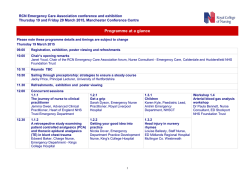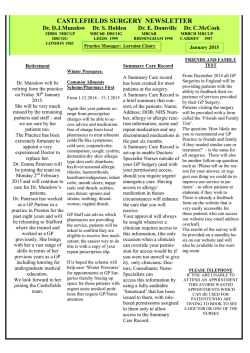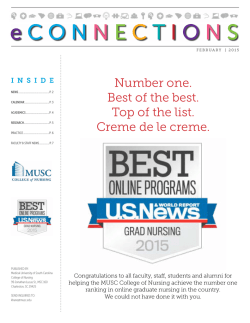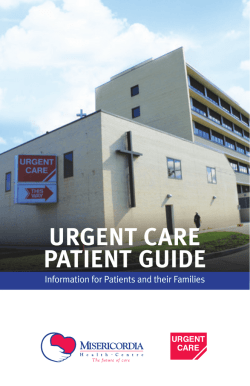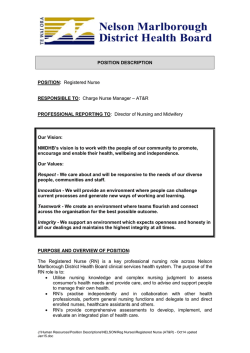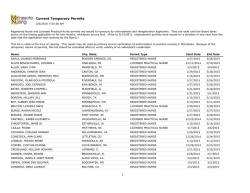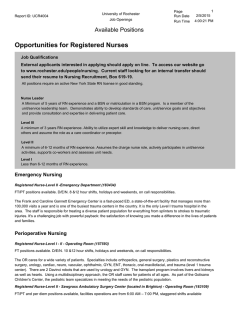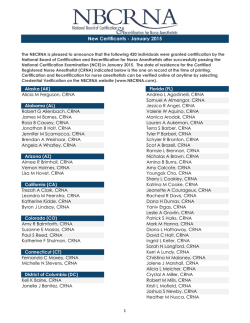
PDF (1 MB) - Nurse Leader
Moving From Patient Care to Population Health: A New Competency for the Executive Nurse Leader Donna M.Watson Dillon, DNP, RN, NE-BC, and Margaret Ann Mahoney, PhD, RN T here are many social, political, and econom- facilitate these changes. Executive nurse leaders are ic influences shaping healthcare delivery trying to navigate through these healthcare changes by today that are expanding the scope of responsibility for developing cost-effective care delivery models, support- the executive nurse leader. The focal point of change is ing the role of the professional and advanced practice the passing of the Patient Protection and Affordability nurse, and advocating for the patient. In healthcare Care Act (ACA), where there is a clear strategic shift to reform, this translates to healthcare being delivered in provide patient care in the right setting with the forma- community venues and the executive nurse leader tion of Accountable Care Organizations (ACOs). being the advocate for the healthcare needs of the pop- Financial reimbursement strategies are being aligned to ulation in the community. 30 Nurse Leader February 2015 ASSESSING GAPS IN COMMUNITY HEALTH NEEDS As part of the doctor of nursing practice program, while spending time in Boston neighborhoods working with Boston Alliance for Community Health, there seemed to be a great disconnect between the health needs of the Boston neighborhoods and health resources available that could impact the health of the community, all of this within the close proximity to several academic tertiary institutions. Being hospital centric the majority of my work life, these observations facilitated a capstone project that was designed to assess and identify gaps in the executive nurse leader’s understanding of community health needs to plan and lead change across the continuum of care. An online survey was distributed to executive nurse leadership in all the hospitals (acute, rehab, and behavioral health) in Massachusetts and Rhode Island. The response rate was 55.7%. The results of the survey indicated that participation in community health initiatives and educational preparation each had a contribution to executive nurse knowledge of community health needs. This research also revealed that most executive nurse leaders are still hospital centric in their vision and operational focus. They have addressed the challenges to provide quality patient care at a reasonable cost with good outcomes in the hospital setting. This focus continues to be embraced with the introduction of value based performance and dependence on the Hospital Consumer Assessment of HealthCare Providers and Systems (HCAHPS) scores for optimal federal reimbursement for their institution. But to achieve the goals of the ACA, a broader vision is needed that incorporates healthcare planning for the community into the role of the executive nurse leader. So comes the transformation. POPULATION HEALTH There is a paradigm shift from a medical care model of symptom management, diagnosis, and treatment of individuals to one of population health management of improving the health for groups of patients with similar needs. The goal of population health management (PHM) is to keep a patient population as healthy as possible, minimizing the need for expensive interventions such as emergency department visits, hospitalizations, imaging tests, and procedures.1 This not only lowers costs, but also redefines healthcare as an activity that encompasses more than sick care, and encompasses the continuum of care. Although PHM focuses partly on the highrisk patients who generate the majority of health costs, it systematically addresses the preventive and chronic care needs of the community that is served by the hospital. In primary care, this is currently being implemented in the patient panels of the medical provider or the formation of medical homes. ROLE OF THE EXECUTIVE NURSE LEADER To make an impact on health and not just provide care, the executive nurse leader needs to be the champion advocate for their specific community health needs utilizing the networking of internal and external resources in the health system and formation of ACOs. The executive nurse leader is in the best position to advocate for the community health needs www.nurseleader.com and be an agent of change. As a leader, one can advocate in obtaining resources, promote improvement of health agendas, identify champions in the health system and community, and partner with the local board of health and other communitybased organizations. To lead the journey on the improvement of population health, the executive nurse leader must understand the specific community health needs of the community. Provisions of the ACA require each nonprofit hospital facility to regularly conduct a community health needs assessment and adopt an implementation strategy to meet identified community health needs. In conducting the assessment, nonprofit hospitals are required to take into account input from persons who represent the broad interests of the community served, including those with special knowledge of or expertise in public health.2 Prior to the passing of the ACA, 12 states, including Massachusetts and Rhode Island, already had regulations or laws requiring community assessments. In my research survey, there were 45 nurse leaders who replied that their hospital conducted a community health needs assessment. Fifty-three percent (n ⫽ 24) of executive nurse leaders had input into the community needs assessment. The nurse leaders most involved with the community health needs assessment were the executive nurse leaders from community hospitals. They were also most familiar with the results of the assessment and the generated report. These plans are public, with some hospitals utilizing their Web site to delineate their community plan. The objective of the community assessment and health planning document is to start to address the community and population needs. It is not meant to be a marketing plan. Unfortunately, programs are sometimes developed and driven by reimbursement incentives instead of the community need to improve health. The lack of behavioral health community resources is a good example. Partnership models should be developed that include the community leaders who can contribute to defining the needs, and healthcare leadership incorporating this information into shared goals and allocating resources and staff to manage the specific health programs that address community needs. EXECUTIVE NURSE LEADER SKILL DEVELOPMENT So, what are the skill sets and experiences necessary for the executive nurse leader to understand community health needs and be an effective community health advocate? The executive nurse leader must be involved in the hospital’s community health assessment process, and the development of the community health needs strategic plan to address the issues. Strategic initiatives should also be integrated into goals of the inpatient and outpatient settings of nursing. One would expect the mission and vision of the hospital would include the community health commitment of improvement in population health. The executive nurse leader needs to know what public, community, federal health, and social determinant data are available regarding the health of their community and how to Nurse Leader 31 understand the relevance of the data and interpret its ramifications to other health leaders. These data should include measures of the social determinants of health. These determinants include environmental (living conditions), cultural (language, nutrition), and socioeconomic (income, education status) factors that impact health. Only 10% to 15% of an individual’s health status is related to the healthcare services provided. The rest of health status is driven by behavior, genetics, and social determinants. That means that the trillions of dollars the United States spends on healthcare services contribute to only one-tenth of the nation’s health.3 So, providing healthcare to improve overall health may be a revolving door. Until as a society we impact the social determinants of health, preventive care and the overall wellness of the patient population will not improve. They need to be able to identify the accessible community resources and ensure current linkages to their health system. In my research, engagement with and in the community was one of the strongest variables in knowledge of community needs. In the capstone project, many nurse executives who participated in community initiatives defined these as hospital readmission programs, transitions in care, and care management redesign. These are really hospital-based initiatives being driven by the financial incentives of the hospital to decrease costs through healthcare reform, not necessarily driven by specific community health needs. Other events included developing safe playgrounds, suicide prevention events, health wellness expos, and team walks supporting cancer care. These events do occur in the community but still are considered hospital-generated community events. The community health needs are being assessed through the lenses of the acute care environment, not from the community viewpoint. The perspective may not bring the value or outcomes needed to improve community health needs. The executive nurse leader should continue to partner, build bridges, and collaborate to incorporate community health resources into setting strategic goals and management priorities. There needs to be greater visibility of the nurse leader and participation within the community. Nursing leadership is going full circle back to our roots with Florence Nightingale and establishing the role of nursing through the US Public Health system. We may find the nurse leaders with a nontraditional education journey of a public health degree may provide valuable insight as healthcare is transformed. NEW ORGANIZATIONAL COMPETENCY FOR THE EXECUTIVE NURSE LEADER AONE is the national organization representing the executive nurse leaders. Their vision is “to shape the future of health care through innovative and expert nursing leadership. Innovative nursing leadership requires that nurses in leadership are competent.”4 The competencies include communication and relationship building, knowledge of the healthcare environment, leadership, professionalism, and business skills. The knowledge of the healthcare environment competency is hospital centric and does not include any reference to inclusion of the community in defining community health needs, 32 Nurse Leader healthcare disparities, and health promotion or population management. The transformation of care is extending beyond the walls of the hospital. AONE is the representative nursing leadership organization that needs to develop a core competency regarding the executive nurse leader whose role is central to defining and addressing community health needs. AONE also has 17 guiding principles, none of which addresses community health needs. AONE could provide the vision by developing competencies on population management that would establish a guiding principle of the continuum of health into the community. Having a dedicated competency/guiding principle would clearly identify and support the importance of the executive nurse leader’s role in transforming the health needs of the community. This competency/guiding principle should include, but is not limited to, community assessment skills, epidemiological data interpretation, language and cultural considerations, and social determinants of health, environmental influences, community-based partnerships, education, and community participation. Health literacy and community empowerment are also considerations. Other professional organizations have recognized the important role of the executive nurse leader regarding community health needs. The American Nurses Association (ANA) Scope and Standard for Nurse Administrators has been the reference for nurse leaders in the provision of care. In outlining the practice environment of the nurse leader, the scope of practice is clear in that “nurses are increasingly collaborating with community partners to expand populationfocused services, requiring nurse administrators to orchestrate and foster such collaborations.”5 The Magnet Recognition Program® of the American Nurses Credentialing Center has also specific expectations for nursing leaders to be involved in community programs. Although there is no specific standard from The Joint Commission on community health outreach, there are health promotion provisions that guide hospitals in providing culturally sensitive and linguistically appropriate care.6 Competencies and guiding principles that support community health needs influence nursing education programs at all levels when developing curricula to support this role transformation. This promotes the integration of professional role competencies and academic education that shape the priorities of future nurse leaders. In June 2014, the Council of Linkages Between Academia and Public Health Practice published the third version of their Core Competencies for Public Health Professionals.7 Twenty national organizations comprise the Council on Linkage, which includes the American Association of Colleges of Nursing, Association of University Programs in Health Administration, and Community-Campus Partnerships for Health (CCPH). CCPH is a nonprofit organization that promotes health equity and social justice between communities and academic institutions (https://ccph.memberclicks.net/about-us). There are 8 Continued on page 36 February 2015 Moving From Patient Care Continued from page 32 domains for practice in this document, organized to reflect skill levels; there are 3 tiers: frontline, supervisory, and executive. These academic core competencies are a great resource to be referenced in developing the AONE competency for population health management. Though they are educational competencies, the executive nurse leader operational role could be the crosswalk between the health system and public health to improve the overall health of the community. CONCLUSION No one person or healthcare institution alone is capable of improving the health of a community. This must be a purposeful, systematic network developed between the health system, public health agencies, local organizations, and the individual behavior to improve the overall health of a population. This kind of collaboration is not commonplace and continues to evolve. The executive nurse leader needs to be involved with community-driven health initiatives and advocate for improvement of overall health. Nurse leaders need to understand the health needs from the perspective of the community to advocate on a health system, local and federal level, and support transparency of community health needs throughout discussions and networking. Only then will inroads be made on the health of the community, and the goals of the ACA for seamless health care across the continuum be realized. NL References 1. Felt-Lisk S, Higgins T. Exploring the promise of population health management programs to improve health. Mathematica Policy Res Brief. August 2011. http://www.mathematica-mpr.com/publications/pdfs/health/PHM_ brief.pdf. Accessed September 1, 2014. 2. National Association of County and City Officials (NACCHO) Web site. http://www.naccho.org/topics/infrastructure/mapp/index.cfm, 2014. Accessed September 1, 2014. 3. Frist WH. Connected health and the rise of the patient-consumer. Health Aff (Millwood). 2014;33:191-193. 4. American Organization of Nurse Executives. 2012–2013 Source Book: A Guide to AONE Resources for Nurse Leaders. Chicago, IL: AONE; 2012. 5. American Nurses Association. Nursing Administration: Scope and Standards of Practice. Silver Spring, MD: Nursesbooks.org; 2009. 6. Tuazon NC. Community outreach: moving beyond hospital walls. Nurs Manage. 2010;41(5):33-36. 7. Council on Linkages Between Academia and Public Health Practice. Core Competencies for Public Health Professionals. June 2014. http://www.phf.org/ resourcestools/Documents/Core_Competencies_for_Public_Health_Professionals_ 2014June.pdf. Accessed September 1, 2014. Donna M. Watson Dillon, DNP, RN, NE-BC, is principal at Applied Management Systems (AMS) in Burlington, Massachusetts. She can be reached at [email protected]. Margaret Ann Mahoney, PhD, RN, is assistant professor, community health coordinator, at MGH Institute of Health Professions (MGHIHP) in Boston. 1541-4612/2014/ $ See front matter Copyright 2015 by Elsevier Inc. All rights reserved. http://dx.doi.org/10.1016/j.mnl.2014.11.002 36 Nurse Leader February 2015
© Copyright 2025
